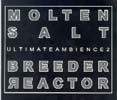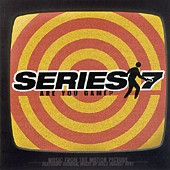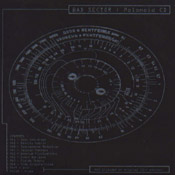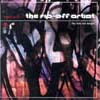- Administrator
- Albums and Singles
 This unusual specimen of audio exotica is a collection of 21 ultra-rarelibrary and production tracks from some huge and bizarre culturalrepository in Southern England, chosen and sequenced by Barry 7 of AddN to (X). This compilation is drawn from the same musical repository asLuke Vibert's recent collection of "Nuggets", but the artistsrepresented here seem to have been chosen with an ear towards morelow-key, eerie synthscapes. Barry 7 provides us with a pleasurable andadventurous journey through science fiction soundtracks, Moog-heavy poptunes, Ennio Morricone-style exotica and pure experimental sonicplayfulness. The artists here run the gamut from pretty obscure toREALLY obscure. Standout tracks include Cecil Leuter's Stereolab-esqueheadphone odyssey "Electro Sounds No. 8" and the melancholy space-agegroove of Sven Libaek's "Solar Flares." Nurse With Wound fans willappreciate the insane whimsy of The Johanna Group's "Hors Phase" andAnthony King's demented pop stylings on "Maladjusted Moogie." Thisstuff is like crack to me. More, please!
This unusual specimen of audio exotica is a collection of 21 ultra-rarelibrary and production tracks from some huge and bizarre culturalrepository in Southern England, chosen and sequenced by Barry 7 of AddN to (X). This compilation is drawn from the same musical repository asLuke Vibert's recent collection of "Nuggets", but the artistsrepresented here seem to have been chosen with an ear towards morelow-key, eerie synthscapes. Barry 7 provides us with a pleasurable andadventurous journey through science fiction soundtracks, Moog-heavy poptunes, Ennio Morricone-style exotica and pure experimental sonicplayfulness. The artists here run the gamut from pretty obscure toREALLY obscure. Standout tracks include Cecil Leuter's Stereolab-esqueheadphone odyssey "Electro Sounds No. 8" and the melancholy space-agegroove of Sven Libaek's "Solar Flares." Nurse With Wound fans willappreciate the insane whimsy of The Johanna Group's "Hors Phase" andAnthony King's demented pop stylings on "Maladjusted Moogie." Thisstuff is like crack to me. More, please!
Read More
- Administrator
- Albums and Singles
 This is not an album by the 60's "it" girl but is the debut full-lengthrelease from crafty Londoner Stephen Coates. His brand of audiopastiche includes a combination of polished beats, Coates' own whisperyvocals a'la Momus, and an array of melodies sampled from 1920s and 30srecordings that will unfailingly give you the urge to get up from yourchair and do the Charleston. Tracks like, "Am I In Love?," and theirrisistably catchy, "L'amour et la Morte," are both funny andcharmingly eerie — something on par with being pitched into the absurdvaudevillian silliness of an episode of The Muppet Show. AlthoughCoates seems perfectly at ease with this silliness, the twoinstrumental tracks, "At the House of the Clerkenwell Kid," and, "CloseYour Eyes When You Read This," which show the more serious side ofTuesday, are some of the standout pieces, seeming to draw heavily onfilm noir score. The overall cinematic quality of Coates' work is hardnot appreciate, even on a first listen. For the most part, however, hissense of humor and wit prevail, especially evident in the song title"Terminally Ambivalent Over You," but never lapses into an undesirablechildishness.
This is not an album by the 60's "it" girl but is the debut full-lengthrelease from crafty Londoner Stephen Coates. His brand of audiopastiche includes a combination of polished beats, Coates' own whisperyvocals a'la Momus, and an array of melodies sampled from 1920s and 30srecordings that will unfailingly give you the urge to get up from yourchair and do the Charleston. Tracks like, "Am I In Love?," and theirrisistably catchy, "L'amour et la Morte," are both funny andcharmingly eerie — something on par with being pitched into the absurdvaudevillian silliness of an episode of The Muppet Show. AlthoughCoates seems perfectly at ease with this silliness, the twoinstrumental tracks, "At the House of the Clerkenwell Kid," and, "CloseYour Eyes When You Read This," which show the more serious side ofTuesday, are some of the standout pieces, seeming to draw heavily onfilm noir score. The overall cinematic quality of Coates' work is hardnot appreciate, even on a first listen. For the most part, however, hissense of humor and wit prevail, especially evident in the song title"Terminally Ambivalent Over You," but never lapses into an undesirablechildishness.
samples:
Read More
- Administrator
- Albums and Singles
 The Molten Salt Breeder Reactor has been noisily unleashing untamedharshness on the world for around a decade or so. It first reached myears via the excellent Ash International compilation "Chiky(u)u" in1997, and has collaborated on ludicrously limited split discs with anendless parade of noisesmiths, including Daniel Menche, Cock ESP, K2and Steve Roden and Brandon Labelle. Koji Tano is a Tokyo noisician whois perhaps predictably rather prolific and has made museuminstallations exploring the interface between art and trash heaps. Herehe blasts eardrums, courtesy of the 20 City label, with two long studiocuts of 'spherical electronics', and a recording of an assault on aprobably quite suspecting Chicago audience, which is a slightly morefrantic but less well defined affair. The first chaotic sphericalrumination opens with a looping skree shard which soon fractures intofeedback squeals and some low messy quakes. A stuttering synthlykeyboard seems to be rapidly losing it's tuning as occasional shadowsof lost keys flicker between the bright gulfs of distortion. MSBR seemsto be able to tweak endless vortices of well defined entropy from hisgadgets, and the noise shifts constantly and eddies endlessly,headlessly and leglessly. Patterns emerge but are quickly blown apart;MSBR kisses the noise as it flies. I find it all quite relaxing at lowvolume and at higher volume it's an ideal obliterative to obtrusivecommercial radio crap.
The Molten Salt Breeder Reactor has been noisily unleashing untamedharshness on the world for around a decade or so. It first reached myears via the excellent Ash International compilation "Chiky(u)u" in1997, and has collaborated on ludicrously limited split discs with anendless parade of noisesmiths, including Daniel Menche, Cock ESP, K2and Steve Roden and Brandon Labelle. Koji Tano is a Tokyo noisician whois perhaps predictably rather prolific and has made museuminstallations exploring the interface between art and trash heaps. Herehe blasts eardrums, courtesy of the 20 City label, with two long studiocuts of 'spherical electronics', and a recording of an assault on aprobably quite suspecting Chicago audience, which is a slightly morefrantic but less well defined affair. The first chaotic sphericalrumination opens with a looping skree shard which soon fractures intofeedback squeals and some low messy quakes. A stuttering synthlykeyboard seems to be rapidly losing it's tuning as occasional shadowsof lost keys flicker between the bright gulfs of distortion. MSBR seemsto be able to tweak endless vortices of well defined entropy from hisgadgets, and the noise shifts constantly and eddies endlessly,headlessly and leglessly. Patterns emerge but are quickly blown apart;MSBR kisses the noise as it flies. I find it all quite relaxing at lowvolume and at higher volume it's an ideal obliterative to obtrusivecommercial radio crap.
samples:
Read More
- Administrator
- Albums and Singles
 The idea of a play-it-in-your-home soundtrack to the massiverobot-destruction performances of Mark Pauline's Survival ResearchLaboratories is ultimately a ridiculous and excessive one. But that maybe the idea. As the uncredited writer of the liner notes explains, "Thewhole point behind the SRL soundtrack is not so much to accompany thesounds of the machines, but to fill in any lulls in the noise level asthe machines start breaking down and falling apart." The performancesare frequently deal with the idea of excess and violent extremes, withgiant mechanical robotic things sent shuddering toward each other andtoward various objects (houses, ugly metal structures of all sorts)with missile launchers, blades, various weapons, any damn thing. Theperformances, typically held in empty parking lots or any large areassome distance from people's homes, are chaotic and seemingly dangerous.The sound is part of the intended perception of a loss of control,though one must trust that the robots' operators know what they'redoing or else they wouldn't knowingly endanger the lives of theiraudience. Or perhaps they would. Who really can say.
The idea of a play-it-in-your-home soundtrack to the massiverobot-destruction performances of Mark Pauline's Survival ResearchLaboratories is ultimately a ridiculous and excessive one. But that maybe the idea. As the uncredited writer of the liner notes explains, "Thewhole point behind the SRL soundtrack is not so much to accompany thesounds of the machines, but to fill in any lulls in the noise level asthe machines start breaking down and falling apart." The performancesare frequently deal with the idea of excess and violent extremes, withgiant mechanical robotic things sent shuddering toward each other andtoward various objects (houses, ugly metal structures of all sorts)with missile launchers, blades, various weapons, any damn thing. Theperformances, typically held in empty parking lots or any large areassome distance from people's homes, are chaotic and seemingly dangerous.The sound is part of the intended perception of a loss of control,though one must trust that the robots' operators know what they'redoing or else they wouldn't knowingly endanger the lives of theiraudience. Or perhaps they would. Who really can say. The soundtracks on this CD, then, are not about dynamics or subtlety,but brute din. They are done by G.X. Jupitter-Larsen, whose work as theHaters celebrates entropy by creating noise out the sounds of things(like tires, calculaters, paper) falling apart. The music here isn't somuch different from his Haters albums, though a slightly differentconceptual element entwines them into the SRL performances. Forexample, a performance at a race track used the sounds of car crashesand motor-racing to "fill in any lulls" in the machine demolitionderby. In order to highlight the humor of the SRL productions (what isa display of absurdly grandiose self-directed violence but essentiallyfunny?), Larsen used the sounds of children's cartoons. And on and on.These concepts are secondary to the unchanging grey wash of high-volumenoise, punctuated by clanging metal, presumably coming from the machineperformances themselves. Yes, it's ridiculous. But it couldn't havebeen anything else! www.subrosa.net
samples:
Read More
- Administrator
- Albums and Singles
 Anyone remember Girls Against Boys? Their funk-soul-sex-rock music onTouch & Go was tearin' up the college music charts in the mid 90s,and the major labels came running. After signing with Geffen, GirlsAgainst Boys -- GVSB -- released their major label debut "Freakonica."To mild acclaim and almost whole ambivalence. No one cared who theywere or what music they were making, it seemed, because the record didnot sell well. And when Geffen all but dissolved in the infamousUnigram merger, GVSB were done. No fear, however. Where some bandsdecided to call it quits or sell out to another major, GVSB stillrecord together and make some amazing music (look for a new album onJade Tree in early summer 2002), despite the band members' projects(New Wet Kojak, for one). This soundtrack to the critically acclaimedmovie "Series 7," a mockumentary-like spoof on reality television wherecontestants are given guns and made to kill to win, is a perfectexample of why this band is in it for the long haul. What a perfectsetting for GVSB. And they make the most of it. The music is asaggressive, sexy, and fresh as it ever was, perfectly conveying, Iwould think, the urgency of said television program. I will admit, nothaving seen the film, I cannot say how this music works for it. But onits own it stands up just fine. The song that reportedly plays over thecredits ("One Dose of Truth") is GVSB gone New Wave, and it isprecious. It's also the only part of the score that has lyrics, sobasically this is a chance for the band to make an instrumentalimpression. There are also a few other songs by other bands on thealbum, included for posterity due to their inclusion in the film, likethe Joy Division classic "Love Will Tear Us Apart." But this is GVSB'ssoundtrack, and a great hint at things to come.
Anyone remember Girls Against Boys? Their funk-soul-sex-rock music onTouch & Go was tearin' up the college music charts in the mid 90s,and the major labels came running. After signing with Geffen, GirlsAgainst Boys -- GVSB -- released their major label debut "Freakonica."To mild acclaim and almost whole ambivalence. No one cared who theywere or what music they were making, it seemed, because the record didnot sell well. And when Geffen all but dissolved in the infamousUnigram merger, GVSB were done. No fear, however. Where some bandsdecided to call it quits or sell out to another major, GVSB stillrecord together and make some amazing music (look for a new album onJade Tree in early summer 2002), despite the band members' projects(New Wet Kojak, for one). This soundtrack to the critically acclaimedmovie "Series 7," a mockumentary-like spoof on reality television wherecontestants are given guns and made to kill to win, is a perfectexample of why this band is in it for the long haul. What a perfectsetting for GVSB. And they make the most of it. The music is asaggressive, sexy, and fresh as it ever was, perfectly conveying, Iwould think, the urgency of said television program. I will admit, nothaving seen the film, I cannot say how this music works for it. But onits own it stands up just fine. The song that reportedly plays over thecredits ("One Dose of Truth") is GVSB gone New Wave, and it isprecious. It's also the only part of the score that has lyrics, sobasically this is a chance for the band to make an instrumentalimpression. There are also a few other songs by other bands on thealbum, included for posterity due to their inclusion in the film, likethe Joy Division classic "Love Will Tear Us Apart." But this is GVSB'ssoundtrack, and a great hint at things to come.
samples:
- Julie Stephanek & Eli Janney - Sweetness Of Mine
- Let's Get It On
- One Dose of Truth
Read More
- Administrator
- Albums and Singles
 A couple weeks ago, I had a lot of time on my hands on the highway toAustin for a Pigface show. I figured it would be a good time to take inthe entirety of this various artists collection handpicked by Pigfaceand Invisible Records head honcho Martin Atkins for Underground Inc.,an affiliation of 15 or so indy labels including Invisible. "Notes.."showcases 52 tracks over 3 discs by 28 artists, none of whom I'dpreviouslyheard of. I kept a simple 'thumbs up' vs. 'thumbs down' tallyas I listened and 20 tracks got the thumbs up. Not bad considering thesingle disc price tag. It's a diverse lot that represents both gendersand many facets of pop, punk, rock, industrial rock, dance, rap, etc.(but you won't find a single glitch) and, of course, the unavoidableSkinny Puppy/Orgy/Leatherstrip imitators. My bias lies more towards theoriginal and weird stuff rather than the cookie cutter refuse. Some ofthe highlights: Louie Fontaine's Foetus like swagger, Tub Ring's cutand paste carnival punk on acid, Kill Pop's explosive Big Black meetsMinor Threat sound and Livesexact's "You Must Get Down" amusing samplesand raps. And the cream of the crop: Mistlethrush's utterly delightfulmelodic rock gems "Heavy Set John" and "Jody Stone" ... they will behuge given proper exposure). Volume 2 was recently released with 2 morediscs packed with another set of artists. I have it on order.
A couple weeks ago, I had a lot of time on my hands on the highway toAustin for a Pigface show. I figured it would be a good time to take inthe entirety of this various artists collection handpicked by Pigfaceand Invisible Records head honcho Martin Atkins for Underground Inc.,an affiliation of 15 or so indy labels including Invisible. "Notes.."showcases 52 tracks over 3 discs by 28 artists, none of whom I'dpreviouslyheard of. I kept a simple 'thumbs up' vs. 'thumbs down' tallyas I listened and 20 tracks got the thumbs up. Not bad considering thesingle disc price tag. It's a diverse lot that represents both gendersand many facets of pop, punk, rock, industrial rock, dance, rap, etc.(but you won't find a single glitch) and, of course, the unavoidableSkinny Puppy/Orgy/Leatherstrip imitators. My bias lies more towards theoriginal and weird stuff rather than the cookie cutter refuse. Some ofthe highlights: Louie Fontaine's Foetus like swagger, Tub Ring's cutand paste carnival punk on acid, Kill Pop's explosive Big Black meetsMinor Threat sound and Livesexact's "You Must Get Down" amusing samplesand raps. And the cream of the crop: Mistlethrush's utterly delightfulmelodic rock gems "Heavy Set John" and "Jody Stone" ... they will behuge given proper exposure). Volume 2 was recently released with 2 morediscs packed with another set of artists. I have it on order.
samples:
- Kill Pop - Bow
- Livesexact - Up to Get Down
- Louie Fontaine - Evil Force in My Pants
- Mistle Thrush - Judy Stone
- Tub Ring - Living with Rene's Head
Read More
- Administrator
- Albums and Singles
 The slipcase for this disc offers little info beyond 3 artist names,track titles and label url in a somewhat difficult to read font. Alittle online research reveals that the artists - Doe, Eso Steel andBirchville Cat Motel - are from New Zealand and the label, 20 City, isbased in Japan. They specialize in the "production and release ofmanipulated sound: experimental, soundscape, ambient, noise,improvisation, textural, drone" and these 3 offer differing butcomplementary examples over 72 minutes. Doe's "Maylar" (maybe theymeant "Mylar"?) and "Polymer" quickly achieve a quiet and compelling,nirvana like state of layered hum. Eso Steel's "A Scratch" ups thenoise ante a tad with more sound tidbits and "Ircania" goes one furtherwith stretches of mild noise and furnace hum. And finally, BirchvilleCat Motel's 3 tracks bet the whole pot with nearly unlistenable,feedback drenched guitar and clutter. "Crystal Freighters" inparticular would warm Caspar Brùtzmann's cockles. Doe receive the blueribbon here and 20 City have been added to the always growing mentallist of labels to keep track of.
The slipcase for this disc offers little info beyond 3 artist names,track titles and label url in a somewhat difficult to read font. Alittle online research reveals that the artists - Doe, Eso Steel andBirchville Cat Motel - are from New Zealand and the label, 20 City, isbased in Japan. They specialize in the "production and release ofmanipulated sound: experimental, soundscape, ambient, noise,improvisation, textural, drone" and these 3 offer differing butcomplementary examples over 72 minutes. Doe's "Maylar" (maybe theymeant "Mylar"?) and "Polymer" quickly achieve a quiet and compelling,nirvana like state of layered hum. Eso Steel's "A Scratch" ups thenoise ante a tad with more sound tidbits and "Ircania" goes one furtherwith stretches of mild noise and furnace hum. And finally, BirchvilleCat Motel's 3 tracks bet the whole pot with nearly unlistenable,feedback drenched guitar and clutter. "Crystal Freighters" inparticular would warm Caspar Brùtzmann's cockles. Doe receive the blueribbon here and 20 City have been added to the always growing mentallist of labels to keep track of.
samples:
- Doe - Maylar
- Birchville Cat Motel - Crystal Firefighter
- Eso Steel - A Scratch
Read More
- Administrator
- Albums and Singles
 Mac McCaughan writes pops songs. He writes them well, whether they befor Superchunk or for Portastatic. So, when he was invited to performas part of an 'original collaboration' with Ken Vandermark as part ofthe Noise Pop festival in Chicago, he was a bit worried. And I can seewhy. Writing pop songs doesn't usually lend itself well toimprovisation. While McCaughan writes music that is structured,melodic, and full of hooks, Ken Vandermark plays (not even writing it)music that is unstructured, improvised, and spontaneous. Fortunately,McCaughan realized that improvisation would be a bit of a stretch andhe and Vandermark decided that it would perhaps be best if they were todo a set which included a few Porstatic songs, a Caetano Veloso song, a're-working' of a Vandermark tuen, and an original composition writtenby McCaughan and then elaborated upon by Vandermark. To add sometexture to the tunes, Vandermark 5 percussionist Tim Mulvenna wasinvited to play with them. While the execution of each song isexcellent and the mastery of each musician's instrument is obvious, thesongs seem to lack the electricity that usually results fromcollaborations. Although each player is playing beautifully, theyaren't playing off of each other and a lack of interaction can beheard. It's almost as if Vandermark was playing along at home to arecording. You can definitely see why this is being called aPortastatic release. Not that it's a bad thing, but it's unfortunate tofind that a collaboration that had such great potential fails todeliver.
Mac McCaughan writes pops songs. He writes them well, whether they befor Superchunk or for Portastatic. So, when he was invited to performas part of an 'original collaboration' with Ken Vandermark as part ofthe Noise Pop festival in Chicago, he was a bit worried. And I can seewhy. Writing pop songs doesn't usually lend itself well toimprovisation. While McCaughan writes music that is structured,melodic, and full of hooks, Ken Vandermark plays (not even writing it)music that is unstructured, improvised, and spontaneous. Fortunately,McCaughan realized that improvisation would be a bit of a stretch andhe and Vandermark decided that it would perhaps be best if they were todo a set which included a few Porstatic songs, a Caetano Veloso song, a're-working' of a Vandermark tuen, and an original composition writtenby McCaughan and then elaborated upon by Vandermark. To add sometexture to the tunes, Vandermark 5 percussionist Tim Mulvenna wasinvited to play with them. While the execution of each song isexcellent and the mastery of each musician's instrument is obvious, thesongs seem to lack the electricity that usually results fromcollaborations. Although each player is playing beautifully, theyaren't playing off of each other and a lack of interaction can beheard. It's almost as if Vandermark was playing along at home to arecording. You can definitely see why this is being called aPortastatic release. Not that it's a bad thing, but it's unfortunate tofind that a collaboration that had such great potential fails todeliver.
samples:
Read More
- Administrator
- Albums and Singles
 Bad Sector is becoming awfully prolific. Of his recent material, oneitem I've enjoyed greatly is the "Bad Box" - which isn't actually new -but rather a reissue of an older album, "Polonoid," and an extra CD-Rwith two great songs on it. (Sadly, the box is now sold out, butPolonoid is available by itself, so if you've never heard of Bad Sectorbefore, snag the un-boxed version.)
Bad Sector is becoming awfully prolific. Of his recent material, oneitem I've enjoyed greatly is the "Bad Box" - which isn't actually new -but rather a reissue of an older album, "Polonoid," and an extra CD-Rwith two great songs on it. (Sadly, the box is now sold out, butPolonoid is available by itself, so if you've never heard of Bad Sectorbefore, snag the un-boxed version.)Let's get off on the right foot: this album fucking rules. Bad Sectorhave existed since 1993 but only recently has he gotten the press hedeserves. Part of what makes him so good is the fact that his music ispretty much unlike any other: it's noisy, it's ambient, it's amazinglyemotional, and it's amazingly creepy. All at once. It's like Farmer'sManual meets Anenzephalia meets Autechre's "VLetrmx21."
"Polonoid" is a prime example of his work. Originally released as avery limited CD-R on Germany's Vuz Records, it is now more widelyavailable (yay!), and features all his trademarks: shifting walls offeedback, droning, melancholy synthesizers, and bizarre cut-up voicerecordings. Sometimes, as on "Open Universe," the music resembles powerelectronics in sheer intensity or volume, and yet it retains melody anda certain digital aspect that other music of this nature lacks thatreally sets it apart.
In summary: Bad Sector is amazing. To quote the artist himself, hismusic is "deeply emotional dark ambient noise," and he is really damngood at what he does. Don't miss out.
samples:
Read More
- Administrator
- Albums and Singles
 A 5-track EP of analog lo-fi electronica from Berlin, presented onthick white vinyl with variable artwork. White labels wich give nofurther clues except one to check the details first as both sides playat different speed.
A 5-track EP of analog lo-fi electronica from Berlin, presented onthick white vinyl with variable artwork. White labels wich give nofurther clues except one to check the details first as both sides playat different speed. Impressions from shady sideways of the datastream appear, titles like"Sentimental Elevator Bits" and "Monomental Intercourse" nearly say itall. Plankton provides a lost futurism a la early Kraftwerk and Numanwith today's tools. "Soleil" would even work in a Metropolis Score -but in a rougher style.
A promising debut which raises expectations.
samples:
Read More
- Administrator
- Albums and Singles
 The second Rip-Off Artist album, "Brain Salad Surgery", was reviewed onthe Brain back in summer around the time it was released. This isactually his first album, which was released by Quatermass only a monthbefore the second due to label procrastination, and after a time warpcaused by a huge pile of promo CD's and not enough ears to go round,this one is getting reviewed so late that the prolific Matt Haines hasalready got a third album out! I can't comment on "Pump" on MillePlateaux as I haven't heard it yet! His Rip-Off Artist persona is acomment on his plunderphonic compositions. He steals bits of otherrecords, even their titles, but hopes that people won't actually stealthis CD. Presumably it's OK to sample his records though. He's sampledchildren's toys and sing-along records to make this funky stew which isa little more obviously humourous than his more streamlined secondalbum. However he doesn't want this regarded as a comedy record, whichis probably just as well when the best joke is a bunch of kids blowingout birthday cake candles shouting, "123, blow!" before a particularlyslick keyboard break. The Rip-Off Artist is perhaps at his best when hemakes wierder noises, as on the appropriately titled 'SomethingStrange'. There always seems to be a fractured and skewed electro pulsetrying to flex, but it usually gets jittered up and slung on its head.'Gizmo' adds some daft sexual innuendo to a Kraftwerk like vocodervoice that sings, "I like to play with my gizmo, I like to play all daylong." Subtract the ribbits and the odd lyric about being a frogwanting a kiss, and 'Cream' is a pretty straightforward electro-funkwork out with a lascivous hopped up rap from Crescent Raye Born. Kidsrecords should educate with amusement, and thanks to the Rip-Off ArtistI now know that Tater Tots are hot, and that they're not a tomato, butI'm not sure exactly what they are. If anyone wants to advertise themthere's a ready made jingle here that could earn Matt Haines a fewpennies. "Would you like a slice of cheese?" asks a chirpy looped womanon the very short track 'Silly'. There's plenty of that to go roundtoo! The second album on Hot Air is more convincing but this is quitean enjoyable dose of daft disco diving.
The second Rip-Off Artist album, "Brain Salad Surgery", was reviewed onthe Brain back in summer around the time it was released. This isactually his first album, which was released by Quatermass only a monthbefore the second due to label procrastination, and after a time warpcaused by a huge pile of promo CD's and not enough ears to go round,this one is getting reviewed so late that the prolific Matt Haines hasalready got a third album out! I can't comment on "Pump" on MillePlateaux as I haven't heard it yet! His Rip-Off Artist persona is acomment on his plunderphonic compositions. He steals bits of otherrecords, even their titles, but hopes that people won't actually stealthis CD. Presumably it's OK to sample his records though. He's sampledchildren's toys and sing-along records to make this funky stew which isa little more obviously humourous than his more streamlined secondalbum. However he doesn't want this regarded as a comedy record, whichis probably just as well when the best joke is a bunch of kids blowingout birthday cake candles shouting, "123, blow!" before a particularlyslick keyboard break. The Rip-Off Artist is perhaps at his best when hemakes wierder noises, as on the appropriately titled 'SomethingStrange'. There always seems to be a fractured and skewed electro pulsetrying to flex, but it usually gets jittered up and slung on its head.'Gizmo' adds some daft sexual innuendo to a Kraftwerk like vocodervoice that sings, "I like to play with my gizmo, I like to play all daylong." Subtract the ribbits and the odd lyric about being a frogwanting a kiss, and 'Cream' is a pretty straightforward electro-funkwork out with a lascivous hopped up rap from Crescent Raye Born. Kidsrecords should educate with amusement, and thanks to the Rip-Off ArtistI now know that Tater Tots are hot, and that they're not a tomato, butI'm not sure exactly what they are. If anyone wants to advertise themthere's a ready made jingle here that could earn Matt Haines a fewpennies. "Would you like a slice of cheese?" asks a chirpy looped womanon the very short track 'Silly'. There's plenty of that to go roundtoo! The second album on Hot Air is more convincing but this is quitean enjoyable dose of daft disco diving.
samples:
Read More